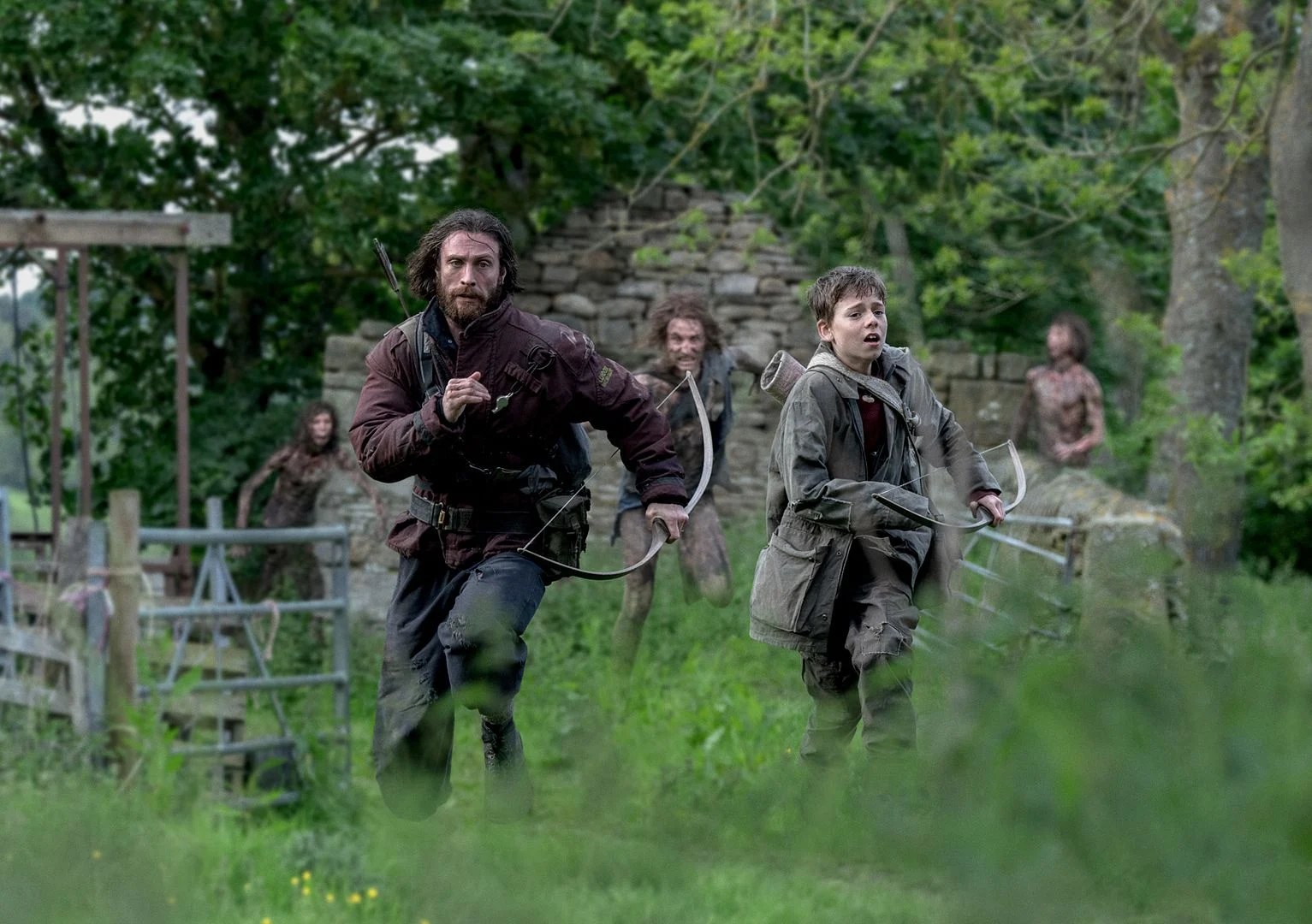Six months ago, one of the most frightening trailers to ever grace screens dropped to mass – apocalyptic – excitement. A sequel to Danny Boyle’s 28 Days Later and Juan Carlos Fresnadillo’s 28 Weeks Later, the successor, 28 Years Later, pitted once again the living dead against a sparse group of survivors to the eerie 1915 recital of Rudyard Kipling’s Boots by actor Taylor Holmes. It was magnetic, tense, beating its own drum beyond the realm of trailer territory. How could Boyle, reprising his role as director for this third instalment, live up to this masterpiece in and of itself? The jury is still out as to whether he did.
28 years after the second outbreak of the virus, the United Kingdom is still in quarantine and closely surveyed from the safety of the sea. Beyond, a survivor community has rebuilt on a tidal island connected to the mainland by a fortified causeway. Their way of living is simple, almost reversed – the roles of the community include baker, farmer and seamster amongst others, and they do not appear to have any contact with the rest of the world, which has been unaffected by the virus. Among them is twelve year old Spike (Alfie Williams), his father Jamie (Aaron Taylor-Johnson) and his mother Isla (Jodie Comer), whose mystery illness has left her bedridden and prone to confusion and memory loss. When Spike accompanies his father to the mainland as part of a coming-of-age ritual, he is introduced to the possibility of a doctor (Ralph Fiennes) on the mainland having the lost knowledge necessary to cure his mother – swayed by mere stories, he sets out to save her.
While its trailer painted it as a tense, action-filled horror, 28 Years Later has a lot more depth and humanity to it, focusing largely on character dynamics and deep-diving into the meaning of life and death now that the dust of chaos and apocalypse has settled. The virus offers a framework, fantastically capturing a world in which humans and infected coexist (at least, from a distance). The survivors know what to expect, how their predators will act – and so in turn, they learn to be the hunters. In parallel, the infected have evolved, shed their clothing, mutated, either into bloated beings who crawl the earth scrambling for worms, or into Alphas, a variant more intelligent and stronger than the others. It is rare a “zombie film” gets far enough to explore what happens after – 28 Weeks Later came close with Robert Carlyle’s new military-esque lifestyle post first outbreak, while Edgar Wright’s Shaun of the Dead offered a humorous alternative in which the slower moving infected are put to work in supermarkets or on game shows. But with 28 Years Later, Boyle is truly creating a chronological roadmap of the zombie apocalypse, one in which characters can begin to question meaning rather than simply react in a desperate attempt to survive. Largely, it focuses on Spike’s becoming as a man, commencing with the ritual he undertakes with his father. Taylor-Johnson is on top form here – there is a sense of childlike fumbling, for an arrow, a doorknob, for footing, things that even Jamie does not seem to have mastered, that makes it truly tense and real, a reminder that though it has been 28 years, this is not a situation that can easily be adapted to (or, in the film’s words: “time didn’t heal anything”). Certainly not one to baby his child, Jamie does not however conform to the typical brute often attributed with the coming-of-age tale either, dexterously navigating soft and tough love with his son. It is what makes him – and Taylor-Johnson’s brilliantly nuanced performance – so complex, and perhaps also contributes to the disappointment that he is not in fact as involved as the trailer lets on. In the first half of the film, music and image coincide beautifully – Boots is used in undertones to majestic effect, and certain sequences, especially in the water, are almost cartoonish in their beauty. In keeping with themes of virtual reversion, there is also random old footage of people shooting arrows or marching to tense effect, like a myriad of generations coalescing. When a sudden tonal shift occurs, it is difficult not to feel thrown, as Spike embarks on a fresh journey with his mother after an almost performative disillusionment with his principal parental figure. And so, we begin again. Jumps like this make this instalment a particularly jagged one, arguably three films masquerading as one and unfortunately, Comer’s Isla also happens to be a lot less interesting than Jamie – despite periods of lucidity, she is largely lost and quiet, and sequences in which her character could have been fleshed out are left largely unexplored, introducing at the crux of her development a Swedish NATO soldier named Erik (Edvin Ryding), who ends up on the mainland after his patrol boat sinks (how much of an impact this character makes is arguable). In the end, Isla is almost a plot point for Spike to discover what it truly means to be a man, which is not entirely a negative – traditional hunting trips may not be for everyone.
A lot of secondary musings, political, biological, existential are crammed into the latter half of the film – the concept of zombie reproduction and potential immunity is raised, though this seems largely unimaginative and a reprise of 28 Weeks Later, in which Catherine McCormack’s Alice is infected but asymptomatic. Allusions to the pandemic and to a disillusionment with modern life populate the conversations between Spike and Erik – in one of few humorous sequences (discounting Fiennes’ Dr Keston’s at times unhinged nature), Spike doesn’t understand the concept of a delivery driver and, when shown a photograph of Erik’s heavily Botoxed girlfriend (on an iPhone which he is unfamiliar with), likens her to someone back on the island who is allergic to shellfish. These small details break away from the timelessness of the 28 franchise, the illusion of another world despite Days and Weeks being set in some of London’s most famous landmarks. Nevertheless, these can be forgiven. It is only in the final scene (an “if you know, you know” moment reminiscent of Sinners’ multi-era music sequence) that 28 Years Later quite literally seems to lose the plot, a complete and utter rupture with the thematics and aesthetic of the rest of the film that comes dangerously close to tipping its entirety into the void of the ridiculous. A post-credit scene might have sufficed in this instance, just enough to hint at the sequel 28 Years Later: The Bone Temple, though this comes dangerously close to Marvel territory. Where does the 28 franchise go from here? If the final scene flows into The Bone Temple, set for an early 2026 release, it may lose the grittiness that made its predecessors so iconic.





